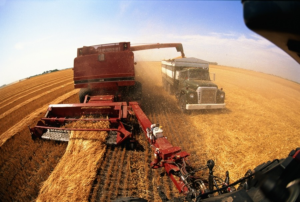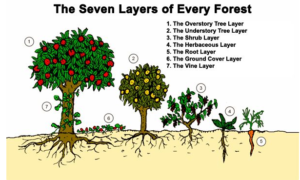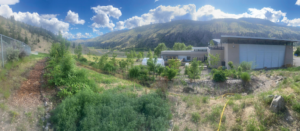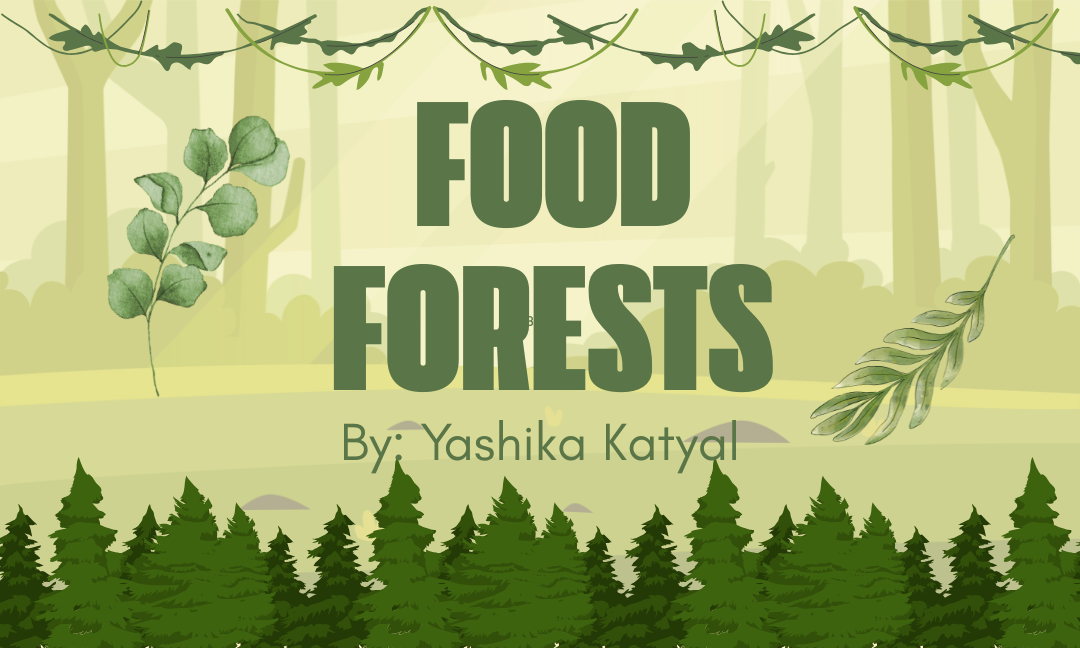Written by: Yashika Katyal
Edited by: Aditya Batra
Designed by: Alishba Khursheed
Published by: Andrew Jackson
Introduction:
In 2021, an astounding 10% of Canada’s total greenhouse emissions came just from the agriculture sector alone, making it one of the highest contributing sectors to global warming in Canada. What if this could be reversed to reduce gas emissions instead? How can sustainability be implemented within agriculture and even within gardens? This is where Food Forests come in! Food Forests, also called Food Gardens, are the production of edible human crops in environments made to mimic forest ecosystems.

How do they work?
While there are many aspects of Food Forests, there are two main features that are necessary to recognize: plant type and plant layers.
Firstly, plant layers exist to incorporate a three-dimensional element to crops, similar to actual forests. While modern day farming practices have reformed to planting in long flat planes as they are cost effective and grant easy machinery use, the many layers within forests are surprisingly beneficial.
Layers within forests are essential for allowing the immense density of plants in forests to occur, as plants are able to grow in all directions. They ensure an abundance of life in a relatively small area. There are 7 layers that are commonly found in forests: The overstory, the understory, the shrub layer, the herbaceous layer, the root layer, the ground cover layer, and the vine layer. Some even like to recognize an eighth layer, the mycelial layer (mainly used for mushrooms). This plethora of growth is what makes forest environments so healthy. Building on this, the next idea to consider are the many advantages to food forests.

Photo credit: Permaculture a Beginner’s Guide by Graham Burnett
Advantages of Food Forests:
Food Forests bring numerous benefits to both the environment and the people who adopt them. One of the main advantages is biodiversity. By mimicking natural ecosystems, food forests encourage a diverse range of species to thrive together. This biodiversity increases resilience to pests and diseases and provides habitats for wildlife. A variety of plant species ensures that the ecosystem remains balanced, something that is often lost in monoculture farming practices.
Another major advantage is sustainability. Food forests reduce the need for chemical pesticides and fertilizers because plants within the forest work together symbiotically. This creates a self-sustaining system that reduces human impact on the environment. In addition, food forests play a crucial role in carbon sequestration. Trees and plants absorb carbon dioxide from the atmosphere and store it in the form of biomass. Establishing food forests is one-way communities can help offset greenhouse gas emissions and combat climate change.
Food forests also contribute to food security. They can provide an abundance of food, including fruits, vegetables, herbs, and even fungi. This form of agriculture reduces dependency on traditional farming systems and can be especially beneficial in urban environments, where access to fresh, local food may be limited.

Popularity and Prevalence:
In recent years, food forests have gained popularity as people become more aware of their environmental and social benefits. Many cities and communities around the world are adopting food forests as a way to promote sustainable living. From small urban gardens to large-scale projects, food forests are increasingly seen as a symbol of hope for the future of agriculture. In places like the United States, Europe, and parts of Asia, food forests are being integrated into public spaces and private properties. Community-based food forests are especially popular, where neighbors come together to grow food, share resources, and create green spaces that improve both mental and physical well-being.

Skeetchestn Community School Food Forest in Kamloops, BC
Examples and Inspiration:
One of the most well-known examples of a food forest in an urban setting is the Beacon Food Forest in Seattle, USA. This seven-acre project provides free food for the local community and is entirely community-driven. It shows how people can come together to create sustainable food systems in urban areas. Similarly, in Kitchener, Ontario, Canada, the Edible Forest Garden offers a great example of how small, local initiatives can impact the broader community. Located in a public park, it provides locally grown fruits, vegetables, and herbs to residents while promoting environmental sustainability and teaching permaculture principles.
In the UK, the Forest of Dean has seen a rise in interest in food forests. Residents there plant a variety of edible crops in the forest understorey, creating forests that provide food, timber, and habitat. This rural example illustrates how food forests can contribute to both environmental restoration and sustainable living.
Additionally, the Greenbelt Movement in Kenya, founded by Nobel laureate Wangari Maathai, promotes tree planting and environmental conservation. While not solely focused on food forests, the movement has inspired many communities to plant trees and edible crops as part of their efforts to combat deforestation and hunger.
Conclusion:
Food forests represent an exciting and innovative solution to the challenges of unsustainable agriculture, climate change, and food insecurity. By mimicking the layers and diversity of natural ecosystems, food forests offer a way to grow food in harmony with nature. They help to rejuvenate the land, promote biodiversity, and provide communities with the resources they need to thrive sustainably. As awareness continues to grow, food forests will likely play an important role in reshaping the future of agriculture, proving that nature’s design can teach us valuable lessons about sustainability and food security.
Sources:
https://projectfoodforest.org/what-is-a-food-forest/
https://permacultureapprentice.com/creating-a-food-forest-step-by-step-guide/
https://www.gardencityharvest.org/what-is-a-food-forest
https://www.seattle.gov/neighborhoods/p-patch-gardening/garden-list/beacon-food-forest

